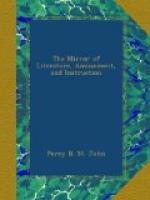G.W.N.
* * * * *
THE COSMOPOLITE.
* * * * *
ARTISTICAL ERRORS.
A SECOND CHAPTER OF BULLS.
(For The Mirror.)
I saw a picture not long since, in Edinburgh, copied from an engraving in Boydell’s Shakspeare; subject,—“Lear (and suite) in the storm,” but coloured according to the imagination and taste of the artist; its name ought assuredly to have been Redcap and the blue-devils, for the venerable and lamented monarch had fine streaming locks of the real carrot hue, whilst his very hideous companions showed blue faces, and blue armour; and with their strangely contorted bodies seemed meet representatives of some of the infernal court.—In a highly adorned prayer book, published in the reign of William III., the engravings of which are from silver-plates, one print illustrates our Lord’s simile of the mote and beam, by a couple of men aiming at each other’s visual organs, ineffectually enough, one having a great log of wood growing from his eye, and the other being blind in one eye from a cataract; at least, though I think I do not err in saying, a moat and castle, in it—I have seen an old edition of Jeremy Taylor’s “Life and Death of Christ,” illustrated with many remarkably good engravings. Of one of these the subject is, the Impotent Man at the Pool of Bethesda; the fore ground is occupied by our Saviour, the cripple, and other invalids; and in the distance appears a small pond palisaded by slender pilasters; over it hovers an angel, who, with a long pole, is, to the marvel of the beholders, dexterously “troubling the waters.” In the same volume, some of the figures are clad in the garb of the time when drawn, and St. Jude is reading the New Testament in a pair of spectacles!—In Holyrood House, and in one of the rooms added in the days of Charles II., is a panel-painting of “the Infant Hercules strangling the serpents;” and leaping up in front of the cradle, appears one of those pretty and rare spaniels called King Charles’s breed. In the same palace, and in one of the chambers, once occupied by the unfortunate Mary, is a very old painting, intended, as the guide assures visitors, to represent St. Peter’s vision of the great sheet; it may be, but if so, one archangel in military sandals, holding in his hands a small towel, represents (by a figure in painting I presume,) St. Peter, the sheet, and its innumerable living contents. He must have taken a hint, from the artist who painted for the passage through the Red Sea nothing but ocean, assuring his employer, that the Israelites could not be seen, because they were all gone over, and the Egyptians were every one drowned!—“I once saw,” writes a friend, “a full length portrait of Wordsworth,




